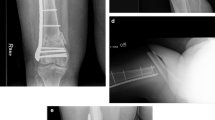Abstract
Background
Osteosynthesis plate removal is one of the most commonly performed procedures in orthopaedic surgery. Due to technological advances and the quality of increasing osteosynthesis material, more and more locked plates have been implanted over the last 20 years. The aim of this study was to determine whether the complication rate during plate removal differs between conventional and locked plates.
Material and methods
In this retrospective cohort study, 620 patients were included and divided into two groups based on the type of plate (locked and conventional). Technical complications during implant removal included screw breakage, destroyed screw head, implant breakage, remaining implant material, refracture, bony or soft tissue overgrowth. The following plate-associated complications were identified: osteosynthesis plate not detachable, plate bent or broken, necessity of special tools or plate loosened. Three types of screw-related complications were observed: screw not detachable, screw broken or screw dislocated.
Results
Overall, complications related to the plate or screws were documented in 110 of the 620 cases. These complications occurred in 48 of the 382 cases involving conventional osteosynthesis (7.7% of all removals, 12.6% of all conventional removals) and in 62 of the 238 cases involving locked plate osteosynthesis (10.0% of all removals, 26.1% of all locked plate removals). The statistical analysis showed a significantly higher implant-related complication rate with locked plates compared to the conventional plates (p < 0.01).
Conclusions
Hardware removal can be a complication-afflicted operation, especially cases involving locked-plate removal should only be performed if a strong indication is evident. Possible benefits of the procedure should be considered carefully, taking the cost-benefit ratio into account.



Similar content being viewed by others
References
Ochs BG, Gonser CE, Baron HC, Stockle U, Badke A, Stuby FM (2012) Refracture of long bones after implant removal. An avoidable complication? Unfallchirurg 115(4):323–329. doi:10.1007/s00113-012-2155-6
Wolter D, Jürgens C (2006) Winkelstabile verbindungen bei osteosyntheseimplantaten. Trauma Berufkrankh 8:206–211
Seide K, Morlock MM, Schümann U, Wolter D (1999) Wirkprinzipien der winkelstabilen Platten-Schrauben-Verbindung bei Fixateur-interne-Osteosynthesen. Trauma Berufkrankh 1(4):320–325
Schmal H, Strohm PC, Jaeger M, Sudkamp NP (2011) Flexible fixation and fracture healing: do locked plating ‘internal fixators’ resemble external fixators? J Orthop Trauma 25(Suppl 1):S15–20. doi:10.1097/BOT.0b013e31820711d3
Voigt C, Lill H (2010) Winkelstabile implantate – fluch oder segen? Trauma Berufkrankh 12(Suppl 4):430–433
Claes L (2011) Biomechanical principles and mechanobiologic aspects of flexible and locked plating. J Orthop Trauma 25(Suppl 1):S4–7. doi:10.1097/BOT.0b013e318207093e
Wagner M, Frigg R (2006) AO manual of fracture management: internal fixators. Thieme, Stuttgart
Weise K (2010) 30 years of osteosynthesis: developments in surgical fracture treatment over the last three decades. Orthopade 39(2):122–131. doi:10.1007/s00132-009-1517-4
Augat P, Simon U, Liedert A, Claes L (2005) Mechanics and mechano-biology of fracture healing in normal and osteoporotic bone. Osteoporos Int 16(Suppl 2):S36–43. doi:10.1007/s00198-004-1728-9
Wolter D, Jürgens C, Wenzl M, Schümann U, Seide K (2001) Titanfixateur-interne-Systeme mit multidirektionaler Winkelstabiler Schraubenlage. Trauma Berufkrankh Suppl 4:425–428
Augat P, Buhren V (2010) Modern implant design for the osteosynthesis of osteoporotic bone fractures. Orthopade 39(4):397–406. doi:10.1007/s00132-009-1572-x
Schwarz N (2013) Metal removal. Eur J Trauma Emerg Surg 39(4):325–326. doi:10.1007/s00068-013-0275-5
Müller-Färber J, Blauth M, Stürmer KM (2008) Implantatentfernung. AWMF-Leitlinienregister Nr. 012/004
Brei-Thoma P, Vogelin E, Franz T (2015) Plate fixation of extra-articular fractures of the proximal phalanx: do new implants cause less problems? Arch Orthop Trauma Surg 135(3):439–445. doi:10.1007/s00402-015-2155-4
Schildhauer TA (2007) Metallentfernungen Zu oft Routine - zu wenig Indikation? Trauma Berufkrankh 9(Suppl 3):292–296
Yao CK, Lin KC, Tarng YW, Chang WN, Renn JH (2014) Removal of forearm plate leads to a high risk of refracture: decision regarding implant removal after fixation of the forearm and analysis of risk factors of refracture. Arch Orthop Trauma Surg 134(12):1691–1697. doi:10.1007/s00402-014-2079-4
Raja S, Imbuldeniya AM, Garg S, Groom G (2012) Difficulties encountered removing locked plates. Ann R Coll Surg Engl 94(7):502–505. doi:10.1308/003588412X13373405386411
Schwarz N, Euler S, Schlittler M, Ulbing T, Wilhelm P, Fronhöfer G, Irnstorfer M (2013) Technical complications during removal of locking screws from locking compression plates: a prospective multicenter study. Eur J Trauma Emerg Surg 39(4):339–344. doi:10.1007/s00068-013-0301-7
Vos DI, Verhofstad MHJ (2013) Indications for implant removal after fracture healing: a review of the literature. Eur J Trauma Emerg Surg 39(4):327–337. doi:10.1007/s00068-013-0283-5
Bednar DA, Grandwilewski W (1992) Complications of forearm-plate removal. Can J Surg 35(4):428–431
Townend M, Parker P (2005) Metalwork removal in potential army recruits. Evidence-based changes to entry criteria. J R Army Med Corps 151(1):2–4
Backes M, Schep NW, Luitse JS, Goslings JC, Schepers T (2015) High rates of postoperative wound infection following elective implant removal. Open Orthop J 9:418–421. doi:10.2174/1874325001509010418TOORTHJ-9-418
Langkamer VG, Ackroyd CE (1990) Removal of forearm plates. A review of the complications. J Bone Joint Surg (Br) 72(4):601–604
Fridberg M, Ban I, Issa Z, Krasheninnikoff M, Troelsen A (2013) Locking plate osteosynthesis of clavicle fractures: complication and reoperation rates in one hundred and five consecutive cases. Int Orthop 37(4):689–692. doi:10.1007/s00264-013-1793-9
Author information
Authors and Affiliations
Corresponding author
Ethics declarations
Conflict of interest
The authors declare that they have no conflict of interest.
Funding
There is no funding source.
Ethical approval
Informed consent was obtained from all individual participants included in the study. The study was approved by the ethical review board of the University of Luebeck, Germany (file number 13–177). All procedures performed in studies involving human participants were in accordance with the ethical standards of the institutional and/or national research committee and with the 1964 Helsinki Declaration and its later amendments or comparable ethical standards.
Rights and permissions
About this article
Cite this article
Neumann, H., Stadler, A., Heuer, H. et al. Complications during removal of conventional versus locked compression plates: is there a difference?. International Orthopaedics (SICOT) 41, 1513–1519 (2017). https://doi.org/10.1007/s00264-016-3352-7
Received:
Accepted:
Published:
Issue Date:
DOI: https://doi.org/10.1007/s00264-016-3352-7




